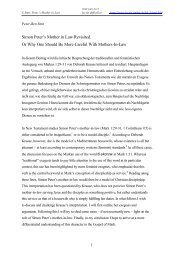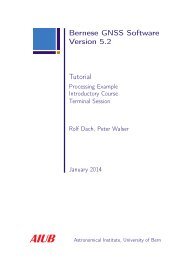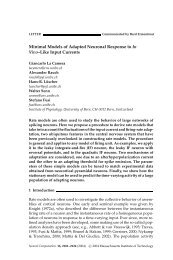The Light Field Camera: Extended Depth of Field, Aliasing, and ...
The Light Field Camera: Extended Depth of Field, Aliasing, and ...
The Light Field Camera: Extended Depth of Field, Aliasing, and ...
- No tags were found...
Create successful ePaper yourself
Turn your PDF publications into a flip-book with our unique Google optimized e-Paper software.
986 IEEE TRANSACTIONS ON PATTERN ANALYSIS AND MACHINE INTELLIGENCE, VOL. 34, NO. 5, MAY 2012REFERENCES[1] E.H. Adelson <strong>and</strong> J.Y. Wang, “Single Lens Stereo with aPlenoptic <strong>Camera</strong>,” IEEE Trans. Pattern Analysis <strong>and</strong> MachineIntelligence, vol. 14, no. 2, pp. 99-106, Feb. 1992.[2] T. Georgeiv <strong>and</strong> C. Intwala, “<strong>Light</strong> <strong>Field</strong> <strong>Camera</strong> Design forIntegral View Photography,” technical report, Adobe Systems,2006.[3] R. Ng, M. Levoy, M. Brédif, G. Duval, M. Horowitz, <strong>and</strong> P.Hanrahan, “<strong>Light</strong> <strong>Field</strong> Photography with a H<strong>and</strong>-Held Plenoptic<strong>Camera</strong>,” Technical Report CSTR 2005-02, Stanford Univ., Apr.2005.[4] A. Veeraraghavan, R. Raskar, A.K. Agrawal, A. Mohan, <strong>and</strong> J.Tumblin, “Dappled Photography: Mask Enhanced <strong>Camera</strong>s forHeterodyned <strong>Light</strong> <strong>Field</strong>s <strong>and</strong> Coded Aperture Refocusing,” ACMTrans. Graphics, vol. 26, no. 3, p. 69, 2007.[5] M. Levoy, R. Ng, A. Adams, M. Footer, <strong>and</strong> M. Horowitz, “<strong>Light</strong><strong>Field</strong> Microscopy,” ACM Trans. Graphics, vol. 25, no. 3, pp. 924-934, 2006.[6] A. Lumsdaine <strong>and</strong> T. Georgiev, “<strong>The</strong> Focused Plenoptic <strong>Camera</strong>,”Proc. IEEE Int’l Conf. Computational Photography, Apr. 2009.[7] A. Levin, W.T. Freeman, <strong>and</strong> F. Dur<strong>and</strong>, “Underst<strong>and</strong>ing <strong>Camera</strong>Trade-Offs through a Bayesian Analysis <strong>of</strong> <strong>Light</strong> <strong>Field</strong> Projections,”Proc. European Conf. Computer Vision, pp. 619-624, 2008.[8] G. Lippmann, “Epreuves Reversibles Donnant la Sensation duRelief,” J. Physics, vol. 7, no. 4, pp. 821-825, 1908.[9] K. Fife, A. El Gamal, <strong>and</strong> H.-S. Wong, “A 3D Multi-ApertureImage Sensor Architecture,” Proc. IEEE Custom Integrated CircuitsConf., pp. 281-284, 2006.[10] C.-K. Liang, G. Liu, <strong>and</strong> H.H. Chen, “<strong>Light</strong> <strong>Field</strong> AcquisitionUsing Programmable Aperture <strong>Camera</strong>,” Proc. IEEE Int’l Conf.Image Processing, pp. V233-236, 2007.[11] M. Ben-Ezra, A. Zomet, <strong>and</strong> S. Nayar, “Jitter <strong>Camera</strong>: HighResolution Video from a Low Resolution Detector,” Proc. IEEE CSConf. Computer Vision <strong>and</strong> Pattern Recognition, vol. 2, 2004.[12] W. Cathey <strong>and</strong> E. Dowski, “New Paradigm for Imaging Systems,”Applied Optics, vol. 41, no. 29, pp. 6080-6092, 2002.[13] H. Nagahara, S. Kuthirummal, C. Zhou, <strong>and</strong> S.K. Nayar, “Flexible<strong>Depth</strong> <strong>of</strong> <strong>Field</strong> Photography,” Proc. 10th European Conf. ComputerVision, Oct. 2008.[14] S.C. Park, M.K. Park, <strong>and</strong> M.G. Kang, “Super-Resolution ImageReconstruction: A Technical Overview,” IEEE Signal ProcessingMagazine, vol. 20, no. 3, pp. 21-36, May 2003.[15] A. Katsaggelos, R. Molina, <strong>and</strong> J. Mateos, Super Resolution <strong>of</strong> Images<strong>and</strong> Video. Morgan & Claypool, 2007.[16] S. Borman <strong>and</strong> R. Stevenson, “Super-Resolution from ImageSequences—A Review,” Proc. Midwest Symp. Circuits <strong>and</strong> Systems,pp. 374-378, 1999.[17] M.K. Ng <strong>and</strong> A.C. Yau, “Super-Resolution Image Restoration fromBlurred Low-Resolution Images,” J. Math. Imaging <strong>and</strong> Vision,vol. 23, pp. 367-378, 2005.[18] S. Farsiu, D. Robinson, M. Elad, <strong>and</strong> P. Milanfar, “Advances <strong>and</strong>Challenges in Super-Resolution,” Int’l J. Imaging Systems <strong>and</strong>Technology, vol. 14, pp. 47-57, 2004.[19] B.R. Hunt, “Super-Resolution <strong>of</strong> Images: Algorithms, Principles,Performance,” Int’l J. Imaging Systems <strong>and</strong> Technology, vol. 6, no. 4,pp. 297-304, 2005.[20] W.-S. Chan, E. Lam, M. Ng, <strong>and</strong> G. Mak, “Super-ResolutionReconstruction in a Computational Compound-Eye ImagingSystems,” Multidimensional Systems <strong>and</strong> Signal Processing, vol. 18,no. 2, pp. 83-101, Sept. 2007.[21] A. Lumsdaine <strong>and</strong> T. Georgiev, “Full Resolution <strong>Light</strong>fieldRendering,” technical report, Indiana Univ. <strong>and</strong> Adobe Systems,2008.[22] T. Georgiev <strong>and</strong> A. Lumsdaine, “<strong>Depth</strong> <strong>of</strong> <strong>Field</strong> in Plenoptic<strong>Camera</strong>s,” Proc. Eurographics 2009, 2009.[23] M. Levoy <strong>and</strong> P. Hanrahan, “<strong>Light</strong> <strong>Field</strong> Rendering,” Proc. ACMSiggraph, pp. 31-42, 1996.[24] J. Stewart, J. Yu, S.J. Gortler, <strong>and</strong> L. McMillan, “A NewReconstruction Filter for Undersampled <strong>Light</strong> <strong>Field</strong>s,” Proc. 14thEurographics Workshop Rendering, pp. 150-156, 2003.[25] J.-X. Chai, S.-C. Chan, H.-Y. Shum, <strong>and</strong> X. Tong, “PlenopticSampling,” Proc. ACM Siggraph, pp. 307-318, 2000.[26] A. Isaksen, L. McMillan, <strong>and</strong> S.J. Gortler, “Dynamically Reparameterized<strong>Light</strong> <strong>Field</strong>s,” Proc. ACM Siggraph, pp. 297-306, 2000.[27] R. Ng, “Fourier Slice Photography,” Proc. ACM Siggraph, vol. 24,no. 3, pp. 735-744, 2005.[28] V. Vaish, M. Levoy, R. Szeliski, C. Zitnick, <strong>and</strong> S.B. Kang,“Reconstructing Occluded Surfaces Using Synthetic Apertures:Stereo, Focus <strong>and</strong> Robust Measures,” Proc. 26th IEEE CS Conf.Computer Vision <strong>and</strong> Pattern Recognition, vol. 2, pp. 2331-2338, 2006.[29] T.E. Bishop, S. Zanetti, <strong>and</strong> P. Favaro, “<strong>Light</strong> <strong>Field</strong> Superresolution,”Proc. IEEE Int’l Conf. Computational Photograph, Apr.2009.[30] T.E. Bishop <strong>and</strong> P. Favaro, “Plenoptic <strong>Depth</strong> Estimation fromMultiple Aliased Views,” Proc. 12th IEEE Int’l Conf. Conf. ComputerVision Workshops, 2009.[31] T.E. Bishop, R. Molina, <strong>and</strong> J.R. Hopgood, “Blind Restoration <strong>of</strong>Blurred Photographs via AR Modelling <strong>and</strong> MCMC,” Proc. IEEE15th Int’l Conf. Image Processing, 2008.[32] T.E. Bishop, “Blind Image Deconvolution: Nonstationary BayesianApproaches to Restoring Blurred Photos,” PhD dissertation, Univ.<strong>of</strong> Edinburgh, 2008.[33] M. Born <strong>and</strong> E. Wolf, Principles <strong>of</strong> Optics. Pergamon, 1986.[34] Z. Wang <strong>and</strong> F. Qi, “Analysis <strong>of</strong> Multiframe Super-ResolutionReconstruction for Image Anti-<strong>Aliasing</strong> <strong>and</strong> Deblurring,” Image<strong>and</strong> Vision Computing, vol. 23, no. 4, pp. 393-404, Apr. 2005.[35] D. Robinson <strong>and</strong> P. Milanfar, “Fundamental Performance Limitsin Image Registration,” IEEE Trans. Image Processing, vol. 13, no. 9,pp. 1185-1199, Sept. 2004.[36] S. Baker <strong>and</strong> T. Kanade, “Limits on Super-Resolution <strong>and</strong> How toBreak <strong>The</strong>m,” IEEE Trans. Pattern Analysis <strong>and</strong> Machine Intelligence,vol. 24, no. 9, pp. 1167-1183, Sept, 2002.[37] A. Papoulis, “Generalized Sampling Expansion,” IEEE Trans.Circuits <strong>and</strong> Systems, vol. 24, no. 11, pp. 652-654, Nov. 1977.[38] E.P. Simoncelli, “Statistical Modeling <strong>of</strong> Photographic Images,”H<strong>and</strong>book <strong>of</strong> Image <strong>and</strong> Video Processing, A. Bovik, ed., second ed.,Academic Press, Jan. 2005.[39] C. Zhou <strong>and</strong> S. Nayar, “What Are Good Apertures for DefocusDeblurring?” Proc. IEEE Int’l Conf. Computational Photography,2009.Tom E. Bishop received the MEng degree inelectronic <strong>and</strong> information engineering from theUniversity <strong>of</strong> Cambridge (Pembroke College) in2004, <strong>and</strong> the PhD degree in engineering fromthe University <strong>of</strong> Edinburgh in 2009. From 2008until 2011, he was a postdoctoral researcher atHeriot Watt University. Since March 2011, hehas worked as a researcher at AnthropicsTechnology Ltd., London. His research interestsinclude computational photography, inverseproblems, image modeling, <strong>and</strong> blind deconvolution. He is amember <strong>of</strong> the IEEE.Paolo Favaro received the DIng degree fromthe Università di Padova, Italy in 1999, <strong>and</strong> theMSc <strong>and</strong> PhD degrees in electrical engineeringfrom Washington University, St. Louis, Missouri,in 2002 <strong>and</strong> 2003, respectively. He was apostdoctoral researcher in the ComputerScience Department <strong>of</strong> the University <strong>of</strong> California,Los Angeles <strong>and</strong> subsequently at theUniversity <strong>of</strong> Cambridge, United Kingdom. Heis now assistant pr<strong>of</strong>essor in the Joint ResearchInstitute for Signal <strong>and</strong> Image Processing between the University <strong>of</strong>Edinburgh <strong>and</strong> Heriot-Watt University, United Kingdom. His researchinterests are in computer vision, computational photography, inverseproblems, convex optimization methods, <strong>and</strong> variational techniques. Heis a member <strong>of</strong> the IEEE.. For more information on this or any other computing topic,please visit our Digital Library at www.computer.org/publications/dlib.
















